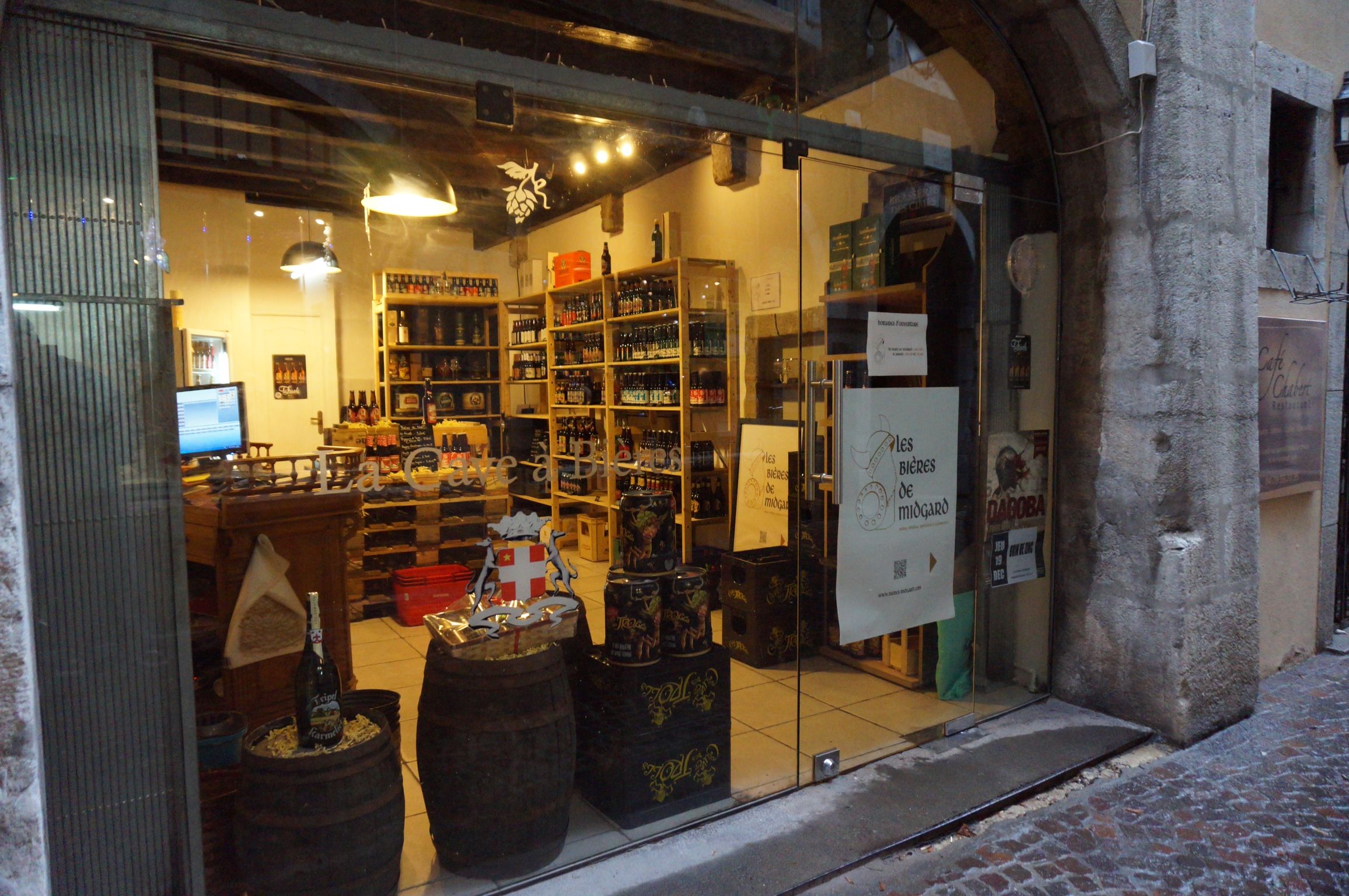Les Biéres à Chambéry et Haute Savoie, France (A Guide to the Beers of the French Alps)
/"Perhaps travel cannot prevent bigotry, but by demonstrating that all peoples cry, laugh, eat, worry, and die, it can introduce the idea that if we try and understand each other, we may even become friends." -- Maya Angelou
Traveling offers one not only an adventure, but a way of getting to know the world a bit better, breaking down the walls that separate us and proving that we are all, despite our differences, much the same. To be a tourist is fine, but to truly travel one has to embrace local culture, be a bit uncomfortable, and explore the world that locals inhabit. Shop where the locals shop, eat what the locals eat, and most importantly, drink what the locals drink. In France that generally means drinking wine, but in some corners the grape has made way for a wee bit of the grain.
Chambéry was once the capital of the Savoie region of France, a duchy that dates back to the 11th century and comprises most of the Western Alps of France. Situated on the borders of France, Italy and Switzerland, this contested region (an independent duchy, a part of France in the First Republic (1792), annexed back to the Italian kingdom of Sardinia/Piedmonte (1815), and finally brought back into France (1860) under the Second Empire) owes its cultural heritage to its varied past.
The region is thus less connected to the traditions of France and maintains an independence to this day. That independence and its geographical location, which makes growing grapes difficult, means that there is a relatively small wine-growing area, and instead of being known for its grapes, the region developed other specialties especially cheese (delicious tommes, Beaufort, and Roblechon) and distillation (Chartreuse, Génépi and Pastis, come to mind and often to my lips), and surprisingly a brewing culture. In fact, legend has it that the city of Chambéry's name may have derived from the Latin name cambarius, meaning "brewer of beer."
The region is home to several artisanal and regional breweries, B.A.S. (Brasserie Artisanale de Sabaudia), Biére de Cimes, Biére du Mont Blanc, Brasserie Galibier, La Cordée à Annecy, Brasserie Ninkasi, Rinck, Brasserie du Mont Salève, and La Soyeuse. Most of these breweries' portfolios include ambrés, blondes and brunes, plus seasonal and specialty varieties, many that include fruit or liqueurs from the region. Biére du Mont Blanc, for example, makes a beer with Genepi (a herbal liqueur).
Rue Basse du Chateau, Chambery
Finding these beers while in the region is challenging; most bars and cafés serve mass produced beers (Heineken, Kronenbourg 1664, Leffe, and Stella Artois top the list) or they serve Belgian bottles, Duvel, La Chouffe, Orval etc...). However, in the center of Chambéry there is a beer oasis of sorts, Les Biéres de Midgard "La Cave à Biéres" a tiny bottle shop on the quaint 14th century Rue Basse du Château where one can find nearly all the specialty beers from the region, an impressive number of Belgian imports, British and Scottish (especially Brew Dog) craft beers and one or two American offerings.
La Cave à Biéres
While I was shopping for regional products, the proprietor was complaining about the beer culture in France and the difficulty he has finding hoppy or interesting beers. And while he was supportive of the locally crafted beers, he obviously would prefer to stock his shop with more "interesting" American style offerings (a trend I wrote about in my last post). As we talked, the subject of home brewing and the difficulty finding ingredients and equipment came up and it was here that he made what might be an obvious but interesting observation: He believes that it will take a home brewing revolution to really change French tastes in beer and get them interested in beer culture. In other words, like the U.S., where home brewers led the craft revolution in the 1970s, the French will remain comfortable with the limited offerings made in their country or look to German and Belgian imports if they look for beer at all until they try their hand at making their own beer. But there is hope in shops like Perceval, run by young people who see the old wine culture of France as an anathema to their generation.
Les Biéres de Midgard
It's going to take some time to explore all the regional beers on offer, but I'll do my best and report the results here. Those that I've had so far, mostly from Brasserie Mont Blanc and Galibeir, have been okay, malty, often sweet with little to no hop bitterness. These are beers brewed with similar recipes of many Belgian beers, but they lack the wonderful complexity of Belgian yeast strands or spontaneous fermentation. Instead the French brewers use a neutral yeast that creates a clean, but often uninteresting beer.
Brasserie Mont Blanc La Blanche
Brassier Mont Blanc Rousse, for instances, poured an amber brown with red tones and looked quite good in the glass, but fell a bit short in the flavor department. This medium-bodied amber was quite sweet, toasted bread and caramel dominated the palate, but there was nothing to the finish, no hop bitterness at all. The blanche or wit was much the same. This one again was beautiful in the glass, but the flavor was a bit dull. The coriander and curaçao orange peel were evident as was a bit of wheat, but it's overshadowed by an almost overpowering malty sweetness that would benefit from a little more spice and a lot more hops. Overall, the Savoyard beers I've tried have been disappointing; the beer is drinkable, if you really want a beer, but they could use a lot refinement.
Brasserie Galibier offers a lineup similar to that of Mont Blanc consisting of a blonde an amber and a blanche. The blonde (Galibier Alpine) is marketed as an "American pale ale," the amber (Galibier Matchut) is listed as a India Pale Ale, and the blanche is supposed to be a Hefewiezen. These are tough labels to live up to, and the beer once again falls a bit short of one's expectations. Don't get me wrong, these beers are good, in fact they're much better than those from Mont Blanc. But the problems lies in expectation; if you call a beer an IPA it has to live up to the name and "Matchut" simply doesn't. Eighteen IBUs does not an IPA make. If anything "Matchut" is a perfectly well-balanced amber and if they left it labeled as such I'd be raving about it. The same goes for "Alpine." Here again we don't have a pale ale instead we are treated to a pleasant and surprisingly good blonde. Again, I think these brewers are playing into the hands of changing tastes in the European market place and rather than being happy producing a fantastic amber, they hype their beer as an IPA in order to sell more of it to a consumer base who's heard the term IPA and wants to be a part of the trend, but who are uneducated in just what an IPA is, and thus buy blindly.
Brasserie des Cimes
Brasserie des Cimes, owned by the Routin Group but claim artisanal status and autonomy from the conglomerate, makes hands down, the best beer from the Savoie. Their Piste Noir and Aiguille Blanche, an amber and wit beer respectively, were very good beers and would hold their own against many Belgian ales. And that's what made these beers so good; like those from Mont Blanc or Galibier, whose beers are largely one-note malty sweet beer, des Cimes start off that way but cut that sweetness using a Belgian-style yeast. Both the amber and the wit thus have the slightly sour, yeasty, banana and clove notes that give interest to what might be an otherwise boring beer. Des Cimes also isn't shy about using hops. Many of the beers I tasted lacked any hop bitterness, most ranging in the 10 - 18 IBU (around the bitterness of a true English mild or brown or even that of a standard American lager), whereas most of des Cimes beers have a noticeable hop bitterness in the 20- 30 IBU range, giving them a pleasant and welcomingly interesting finish.
Brasserie Artisanale Du Dauphiné
I had held out hopes that Brasserie Artisanale Du Dauphiné would prove as interesting as their ingredients, but unfortunately my hopes were dashed. Dauphiné's Mandrin lineup is brewed with herbs and spices rather than hops. Mandrin Au Chanvre (flavored with hemp seed), Mandrin à La Réglisse (licorice), Mandrin Au Sapin (spruce tips), and Mandrin Aux Noix (walnuts) all looked delicious, but they were the most disappointing of the bunch. Billed as an herbed spice beer, an English stout, a biere de garde, and a dark amber respectively, they were all almost undrinkable. In fact, the 10th Anniversary beer went straight down the drain after just a couple of sips. Most of these beers were indistinguishable from each other, all amber/carmel malt notes, sweet and no hop bitterness to speak of. The only difference was the flavoring adjuncts, which in most cases added almost nothing to the beer. I suppose if you tried hard enough and used your imagination you might be able to pull herbs, licorice or nuts, but I couldn't.
Perhaps these complaints are unwarranted given my palate is accustomed to American styles, but the brewers claim to be making craft beer in the style of American, British or Belgian ales, and if that's case the they have a bit of work still to do.
I'm off to the heart of French wine country (Bordeaux) tomorrow and my journey to find a good beer in France will continue. Stay tuned...
Brasserie Artisanale de Sabaudia









